Cakes & Pastries- A bakery delicacy
{Topic content:– Definition of cake, characteristic of cakes, brief history of cakes making from ancient to present, Ingredients used in cake making, methods, Difference between cakes & pastry, cake decorating trends, traditional cakes popular around the world etc}
Definition of cakes:-
- Cake is often served as a celebratory dish on ceremonial occasions, such as weddings, anniversaries, and birthdays.


Pic source-foodnetwork
Characteristic of Cakes
A good quality of Cake must have the following characteristic. These characteristics can vary widely depending on the type of cake and the cultural or personal preferences behind its creation.
Texture in cake:
- Light and Fluffy: Many cakes like sponge cakes and chiffon cakes have a soft & airy texture due to the incorporation of air into the batter often through the beating of eggs or the use of a leavening agent.
- Dense and Moist: Cakes like pound cakes or cheesecakes are denser and have a rich moist crumb. This is often achieved by using a higher proportion of butter, oil, or other fats.
- Sweetness & Flavor:
- Sweet: Cakes are generally sweet with sugar being a primary ingredient. The level of sweetness can vary depending on the recipe and the type of cake.
-
- Flavor Variations: Cakes can be flavored with vanilla, chocolate, fruit, spices, nuts, and other ingredients to create a wide range of flavors. For example a carrot cake might include spices like cinnamon and nutmeg, while a lemon cake would have a citrusy flavor.
Appearance:
- Layered: Many cakes such as birthday or wedding cakes are made up of multiple layers of cake with fillings like frosting, cream, or jam between them.
-
- Frosting and Decoration: Cakes are often frosted and decorated, sometimes elaborately, with buttercream, fondant, ganache, or glaze. Decorations can include sprinkles, edible flowers, or intricate designs.
-
- Shape: Cakes can be made in various shapes and sizes, from traditional round or square cakes to more creative shapes for special occasions.
-
- Moist: A well-made cake is usually moist with the right balance of ingredients to ensure that it doesn’t dry out. Ingredients like butter, oil, yogurt, or buttermilk can contribute to moisture.
- Dry: Overbaking or using too little fat or liquid can result in a dry cake.
- Moist: A well-made cake is usually moist with the right balance of ingredients to ensure that it doesn’t dry out. Ingredients like butter, oil, yogurt, or buttermilk can contribute to moisture.
Structure:
- Crumb: The crumb refers to the texture of the cake’s interior. A fine crumb is soft and even, while a coarser crumb might be more rustic. The structure is influenced by the type and amount of flour used, as well as the mixing technique.
Leavening:
- Risen: Most cakes rise during baking due to the incorporation of air or the use of leavening agents like baking powder, baking soda, or whipped eggs.
- Flat: Some cakes, like flourless chocolate cakes or cheesecakes, are meant to be flat and dense, without significant rising.
Purpose:
- Celebratory: Cakes are often associated with celebrations and special occasions, such as birthdays, weddings, and holidays. They can be customized to fit the theme of the event.
-
- Everyday: Some cakes, like pound cakes or bundt cakes, are simpler and more suited for everyday enjoyment, often served with tea or coffee.
Journey of cake from ancient to present
The word Cake is derived from the word “Kaka” which means Flatbread. The earliest cakes were very different from the cakes we know today. They were more like bread and were sometimes even savory. The first cakes were probably made in ancient Egypt. The Roman Empire also had a long tradition of baking cakes.
The history of cake making spans thousands of years and reflects the evolution of culinary techniques, ingredients, and cultural practices.

pic ref:-https://gurgaonbakers.com/blog/history-of-cake/
Ancient Origins:
- Ancient Egypt (c. 2500 BCE): The earliest forms of cakes were more like sweetened bread. Egyptians are believed to have made honey-sweetened cakes, often with nuts and fruits. These early cakes were dense and bread-like, using honey as a natural sweetener.
- Ancient Greece and Rome: The Greeks made a cake called “plakous,” which was made with nuts and honey, while the Romans developed a cake called “libum,” a simple form of cheesecake used in religious offerings. They also had “satura,” a flat, heavy cake.
Middle Ages (5th to 15th Century):
- Medieval Europe: Cakes began to more closely resemble what we think of today with the use of eggs and butter to create a lighter more cake-like texture. However, sugar was still a luxury so honey was often used as a sweetener. Cakes were often fruit-based and used spices like cinnamon, cloves, and nutmeg which were becoming more widely available due to trade.
Early Modern Period (14th to 18th Century):
- The development of refined sugar in the 16th century allowed for sweeter & more delicate cakes. During this period cakes began to incorporate more elaborate decorations and fillings, becoming centerpieces for celebrations.
- The introduction of beaten eggs as a leavening agent (before chemical leaveners like baking powder) allowed for lighter & fluffier cakes. The first modern cakes similar to what we recognize today began to emerge during these period.
18th and 19th Century:
- The invention of the whisk and advancements in baking technology (like ovens that allowed for more consistent baking) led to further developments in cake making. Sponge cakes which are light and airy became more popular.
- The introduction of baking powder and baking soda in the mid-19th century revolutionized cake baking, making it easier to achieve a light texture without extensive beating of eggs. This period also saw the rise of elaborate cake decorations.
20th Century to Present:
- Cake mixes and pre-made ingredients became available, making cake baking more accessible to home cooks. The variety of cake flavors, fillings, and decorations expanded dramatically during this period. Cakes became more diverse with influences from different cultures and the availability of new ingredients.
- Today cake making is a blend of tradition and innovation. There is a strong interest in both classic recipes and new experimental flavors and techniques. The rise of television baking shows and social media has also fueled a global cake-making culture with bakers sharing intricate designs and recipes worldwide.
Ingredients used in making Cakes
Cake preparation typically involves a combination of basic ingredients that work together to create the desired texture, flavor, and structure. Here are the key ingredients commonly used in cake baking:
1. Flour:-
- Provides structure and body to the cake. Soft flour is most common, but cake flour (which has a lower protein content) is often used for a lighter, more tender crumb.
2. Sugar
- Sugar Sweetens the cake, helps in browning and contributes to moisture. Caster sugar is most common sugar used in cake preparation but brown sugar, powdered sugar, or other sweeteners like honey or molasses may also be used depending on the recipe.
3. Eggs
- Egg help in Binding the ingredients together, provide moisture and contribute to the cake’s structure and leavening. Egg yolks add richness while whipped egg whites add lightness to cakes.
4. Fats
- Fats add moisture richness and tenderness to the cake. Butter or Margarine is one of the important fats used as a shortening in cake preparations.
5. Leavening Agents
- Leavening agent like Baking powder helps the cake to rise by producing gas bubbles in the batter. Baking powder is the most common chemical leaveners in cake preparation. Beaten eggs & egg whites can also act as a natural leavening agent in some cakes.
6. Liquid or Moisture
- Moisture like water or milk Hydrates the dry ingredients, activates the leavening agents and helps to create the cake’s batter consistency. Milk is commonly used but other liquids like water, buttermilk, sour cream, or even juices can be included depending on the recipe.
7. Flavorings
- Flavoring helps to Enhance the taste of the cake. Vanilla extract is most common flavoring used in the cakes but other flavoring like almond, lemon, or mint can also be used. Spices like cinnamon, nutmeg & mace, cardamon etc.), citrus zest, cocoa powder, coffee, and other flavorings are also common.
8. Salt
- Salt balances the sweetness and helps to enhances the flavors of the other ingredients. Regular table salt or fine sea salt should be used in small quantities in cake preparation.
9. Additional Ingredients
- Fruits and Nuts: Add texture, flavor, and moisture. Fresh, dried or candied fruits as well as various nuts can be mixed into the batter or used as decorations.
- Chocolate: Can be added in various forms (cocoa powder, melted chocolate, chocolate chips) to create chocolate cakes.
- Frostings and Fillings: Creams, buttercreams, ganaches, and jams are often used to layer, filling and decorate cakes.
10. Stabilizers/Binders (Optional)
- Stablizers like Gelatin, corn starch or Pectin help in maintaining the structure of the cake, especially in complex recipes.
Each ingredient plays a specific role and the proportions can be adjusted to create different textures, flavors and types of cakes.
Difference between cakes & Pastry
The basic difference between Cakes & Pastry are :–
- Pastries are smaller in size than cakes and Cakes are often round or square in shape and can be quite larger in shape than pastry. Pastries typically contain more sugar and butter than cakes and they often have a crispy crust. Pastries are often shaped into triangles or rectangles and include varieties like pies and eclairs, especially in Western cuisines.
- On one hand, cake includes many ingredients and a complicated procedure for preparation; pastries involve minimum ingredients and simple making procedure. Cakes can be with or without icing. But pastries always have an icing. When a small piece of cake is individually garnished and served, it is sold as a pastry.
- The pastries are generally cut or make into various shapes with the help of pastry moulds such as circles, rectangles, square, Triangle etc and it is usually layered same as layered case and coated with cream, icing etc.
- In a nutshell, all pastries are cakes, but not all cakes are pastries. And the main difference lies in the fact that cakes involve many ingredients that are nutritious too, while pastries use only a few ingredients.
- Cake is more of an occasional food item that is used for celebrations like birthdays, weddings, marriage anniversaries and other merry events. Whereas, pastries are more like a daily food item (in different cultures) and is consumed in breakfast and high-tea.
- Note– there are many pastries which is baked and prepared with the puff or laminated pastries contains very high amount of fats. In this topic we are mainly discussion with the pastries (small layered cake) which is usually prepared from cake sponge.
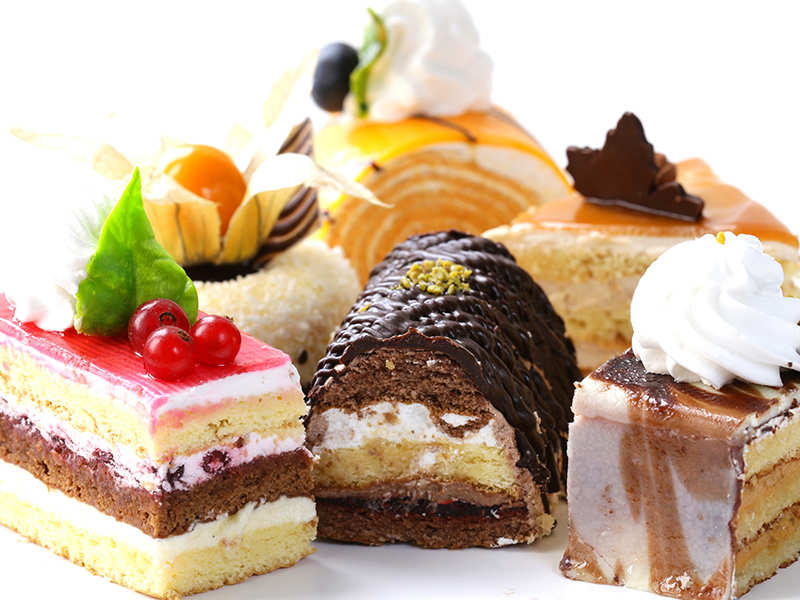
Pic source-times food.
Is it possible to make cake by use of Yeast instead of Baking Powder:-
Yes, theoretically it is possible to make a cake using yeast instead of baking powder, but the texture and flavor of the cake will be different from those made with chemical leaveners like baking powder or baking soda.
Since, yeast is a living agent which has potential to continuous produce the Alcohol & carbon di-oxide during fermentation & proofing stage until it comes in contact with the heat above 65 degree Celcious. it is difficult to hold the Co2 gas in the cake mixture resulting cakes will flatten when baked as cake batter does not have the potential to hold the Co2 gas due to very weak gluten formation in cakes batter.
Cake preparation methods & Technique: –
Cakes are basically made from fat, flour, sugar and eggs, with the exception of the sponge, which is fatless. The texture of the cake generally varies according to the proportion of Fat to Flour ratio in the cake and according to the method of preparation of cake.
- Cakes are generally flavored with numerous flavorings such as Vanilla, strawberry, chocolate, coffee to coconut, orange or lemon etc. The amount of fat in the cake product will determine how long the cake will stay fresh –without drying out. Cakes cannot be made successfully with low fat spreads; this is because they contain a higher proportion of water.
- There are so many ways to mix up the cake batter & each method results in a different cake product from a lighter cake to richer cake.
There are two most important cake preparation methods are adopted world wide.
- Creaming method or Conventional method
- Whisking method
Creaming Method:-
It is also called Conventional Method. This cake mixing method is a classic, and the most common. It is used for cakes that contains more fat and sugar as compare to flour such as sponge cake. The case which is prepared by using creaming method will last longer as they have more fat.
- The creaming method for making cakes is the standard technique used for mixing butter cakes such as pound cake and coffee cake. The purpose of this method is to create an emulsion with the butter and sugar and to slowly work in the rest of the liquid ingredients in a way that will keep the emulsion stable so that the cake will have an even final crumb.
- It is one of the most widely used methods of mixing cookie and cake batter. This method allows for a nice balance between tenderness and structure–yielding an end product.
Is there any difference in the method of creaming used for cake making & creaming method for cookies making:-
| Creaming for cake making | Creaming for cookies making |
| The procedure is basically the same. It’s just a matter of degree or how much creaming and at what speed. | |
| Creaming should be done at medium to high speed by mixing machine until the batter gets light & fluffy. High speed mixing tends to destroy or reduce the number of air cells that are formed and incorporated during the early stages of mixing. | Creaming should be done at low speed by mixing machine until the batter gets smooth & well blended. |
Step of making cake by using creaming method:-
Step -1:- Assemble all the ingredients such as cake flour, sugar, butter, egg, baking powder etc and measure it as per your recipe. The creaming method starts with beating the butter and sugar together until they’re lightened as fluffy.
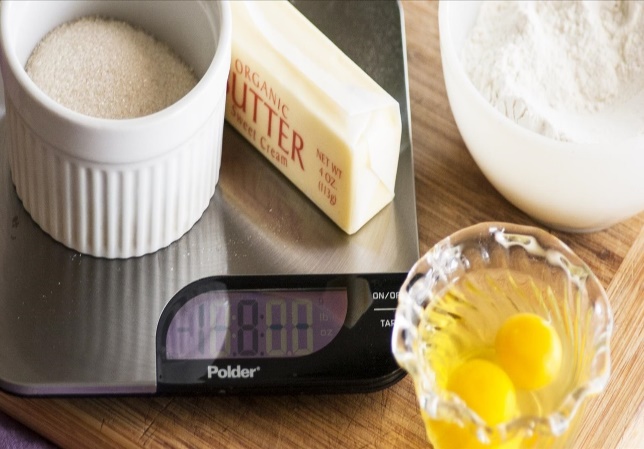
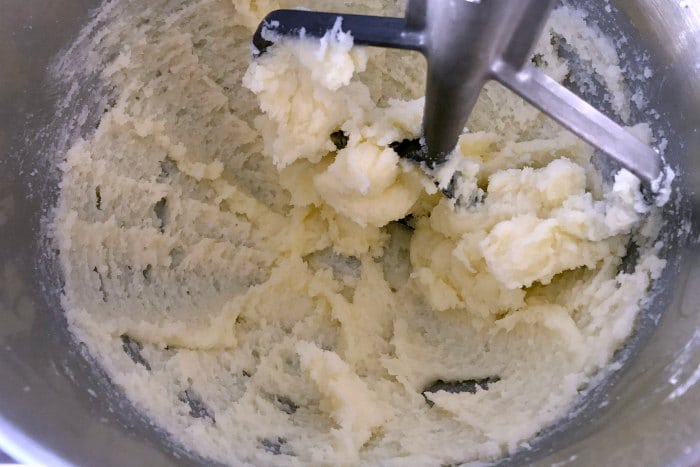
Pic source-bakers.com
Step-2 Add the egg one by one in the fat & sugar mixture & continue creaming it. After each egg is added, mix until it is completely absorbed into the mixture before adding the next one. This ensures that you will not break the emulsion you created during the creaming process. Adding eggs too quickly or adding all the other liquid (milk) at once will cause curdling.
Note:- Since Egg yolks also contain a lot of fat and the mixture can not incorporate too much fat at once & there is a chances that the creamed mixture can break. Therefore, add the eggs in slowly i.e one by one, this will help to form the emulsion well
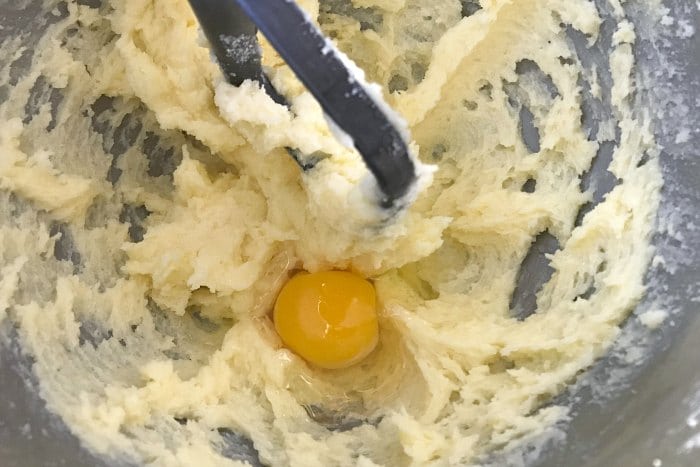
Step-3:- Add cake flour slowly into the fat, sugar & egg batters to form structure of the batter. Rest ingredients like Flavouring & raising agents should be added at this stage such as, Baking powder, vanilla essence & nuts etc.
- Addition of a small portion of the flour at the start of the mix will help to eliminate curdling in mixes with high liquid content. Adding flour alternately with the liquid after the mix is creamed will also eliminate the curdling tendency. The batter is then mixed slowly until smooth and the flour completely mixed in and wet.
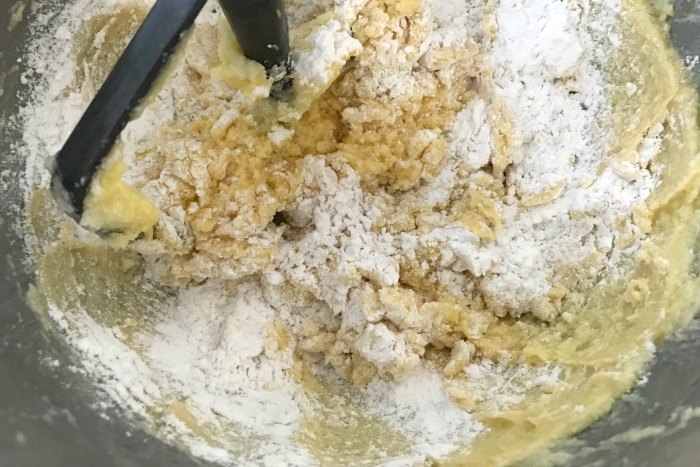
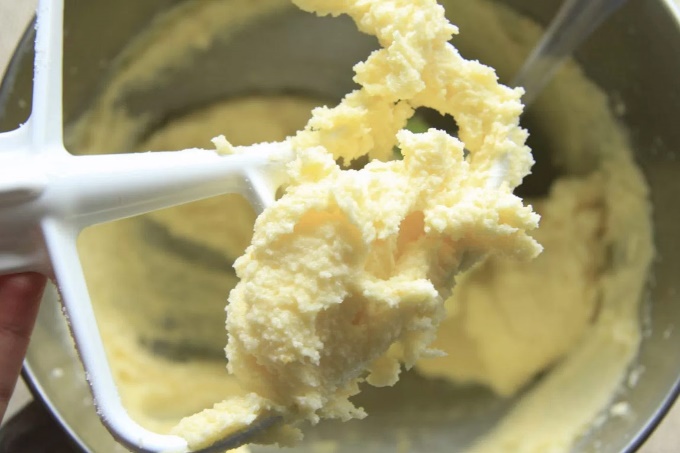
Pic source-bakersbettie.com
Step-4:- Pour the mixture in the cake moulds & bake it in pre-heated oven at 180 degree C for 25-30 minute depending upon the volume of the cake batter in the moulds.
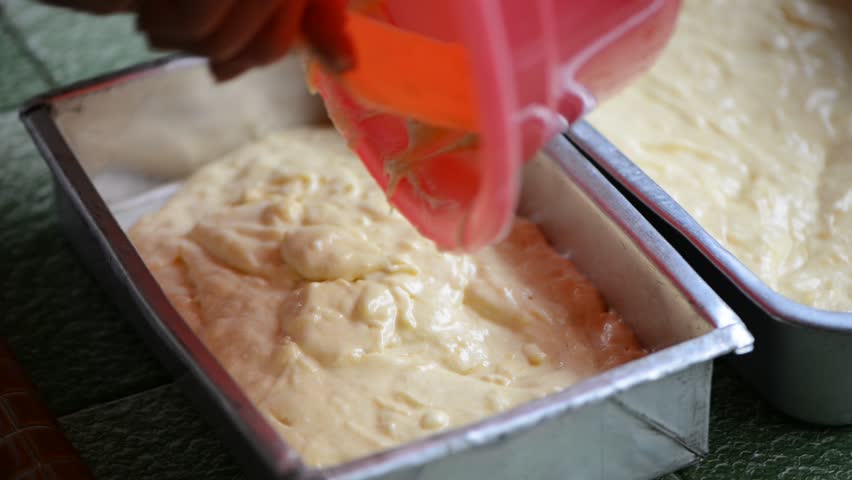
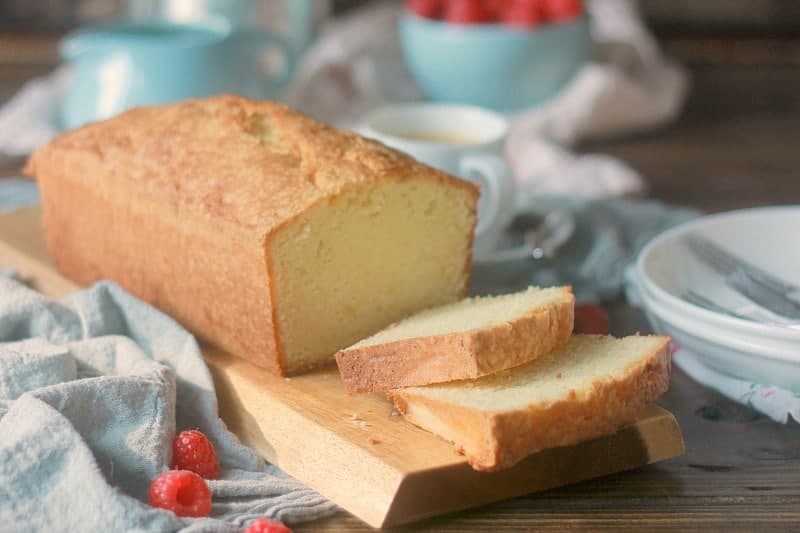
Pic source-Shutterstock & bakerbettie.com
The Whisking Method or Whipping method: –
The whisking method is one of the most common method used in the cake making process today. In this method, egg and sugar is whisked to a ribbon stage that means the egg & sugar mixture should be thick enough to lift or hold. After achieving the correct consistency from egg & sugar mixture, the other ingredients such as bakery flour, baking powder, flavouring etc are added or folded gently in this mixture in batches wise.
- Whisking method does not contains any fat.
- During egg whipping, air cells are formed and incorporated into the mix. Eggs and sugar should be bring to room temperature before whipping to soften the egg yolk and allow quicker whipping and greater volume. Egg yolk contains lecithin which surrounds the bubbles in the foam.
- It has been found that an addition of 20% egg yolks to the whole eggs will improve the foam formation during whipping. For some types of sponge cakes it is advisable to whip the yolks and part of the sugar first, then the egg whites and remaining sugar are whipped and the two whipped products combined. This has the advantage of producing maximum aeration of the foam formed in the whipping of the eggs. For whipped sponge cakes, flour should be sifted and folded in gently in stages to ensure that aeration is maintained. Loss of aeration results in a smaller product with a coarse texture.
Step of making light sponge cake base by whisking methods-
Step-1 :– Whip the egg yolk with half of its confectionary sugar to ribbon stage to get the mixture light, pale, and frothy consistency. Transfer the mixture to a container for mixing the half cake flour slowly by folding it with rubber spatula or by hand very carefully.


Step-2: Beat egg white separately with half of the sugar to create light & fluffy sponge. Mix the self-raising cake flour with the above mixture by cut and fold method.
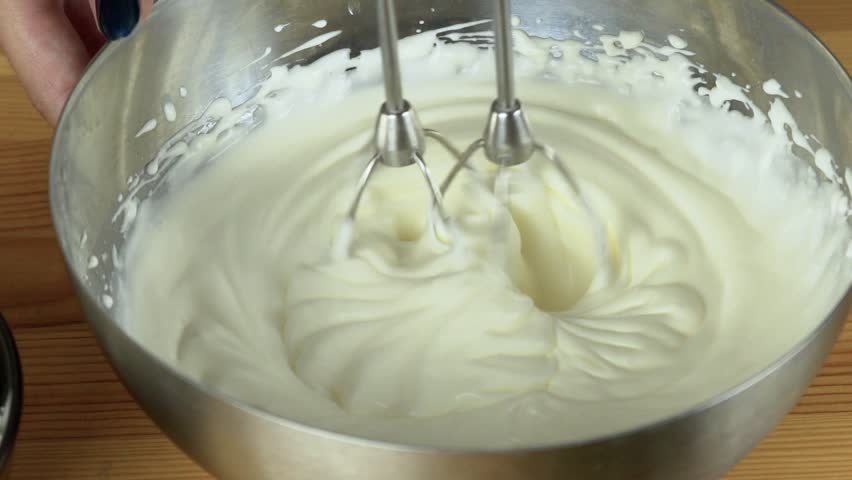 Transfer the above mixture to the creased cake pan, Tray or mould and baked in the pre-heated oven at 180 – 190 degree C.
Transfer the above mixture to the creased cake pan, Tray or mould and baked in the pre-heated oven at 180 – 190 degree C.
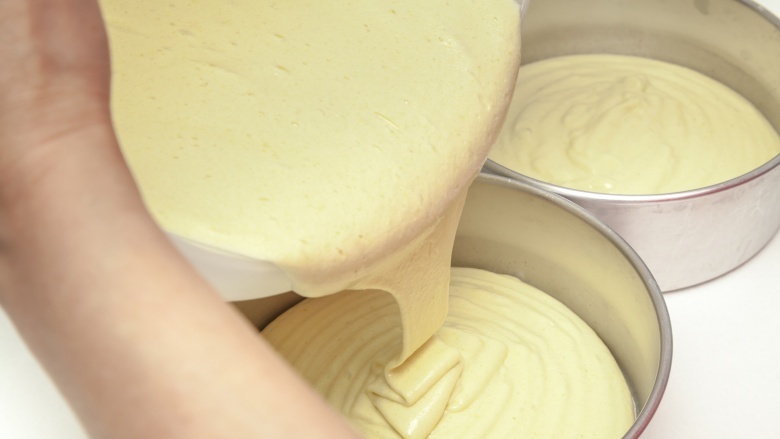
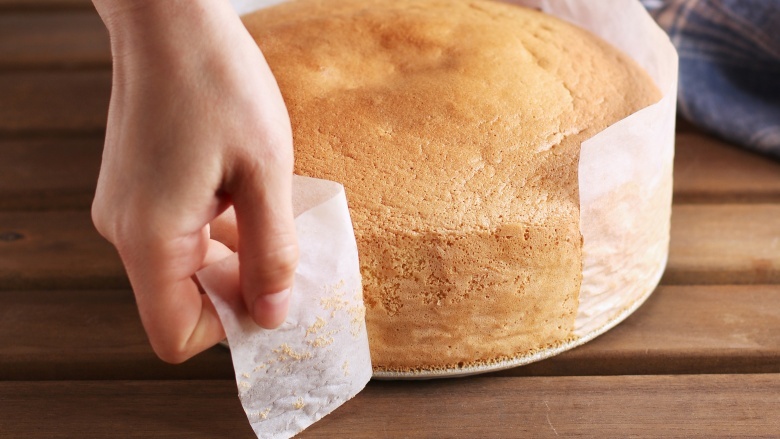
Is there any difference between cake & gateaux?-
Cake and gateau are two words we usually find confusing since different people use these words in different ways and these two desserts have the same basic ingredients. Basically, gateaux are more elaborate than cakes and contain several rich layers.
The main difference between cake and gateau is that cake is a sweet food made with a mixture of flour, eggs, sugar, and butter or oil whereas gateau is a light sponge cake with a rich icing or filling.
| Cake | Gateaux |
| A cake is a sweet baked dessert that is made up of flour, sugar, eggs, butter and leavening agents like baking powder. Cakes can also include various additional ingredients like chocolate, fruits and nuts etc. We usually consider cakes as celebratory deserts; that’s why we eat cakes on happy occasions like birthdays and weddings. | A gateau is a type of cake. In fact, in the word gateau is French for cake. However, in general usage, we consider gateau as a light sponge cake with a rich icing or filling. Therefore, gateau is a more elaborate and fancy dessert than cake. |
| Cakes may have one or more layers | whereas gateaux have several layers with rich fillings. |
| Moreover, the outside of cakes is usually decorated with frosting and icing. | gateau is a more elaborate and fancy dessert than cake. It may have many rich layers made up of ganache, mousse, or fruit filling, etc. |
| There are various types of cakes as well as various cake recipes. Some of these include sponge cake, ribbon cake, marble cake, chocolate cake, rich cake, fruit cake and coffee cake. | In addition, gateau also takes a long time and more effort to make. Another important fact about gateau is that gateaux that are made fruits tend to wilt rather easily; therefore, they are usually intended to be eaten on the same day they are made. |
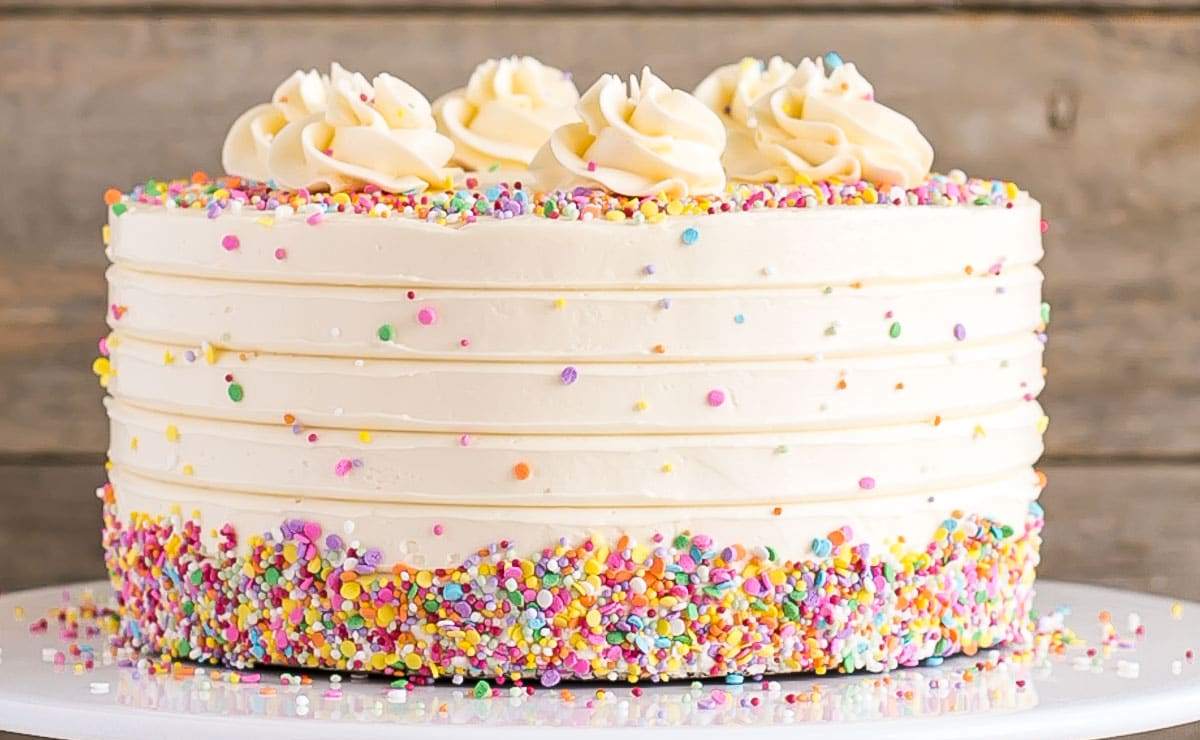 |  |
Top cake decorating trends
Modern cake decorating trends are continually evolving, driven by innovations in techniques and materials, as well as changes in aesthetic preferences. Here are some of the prominent trends in modern cake decorating:
- Comic-style cartoon cakes:- Comic cakes or cartoon cakes are regular cakes that are decorated to look like 2D cartoons. Cartoon cakes are the new baking trend popular among childres. Most of the comic-style cakes have outlines with piped black icing for creating 2D Shapes.

Pic source-https://www.chicaandjo.com/10-cartoon-cake-ideas-comic-book-cake-trend/
- Abstract Buttercream:- Abstract buttercream cakes are a contemporary trend in cake decorating that emphasizes artistic expression and visual impact through the use of buttercream frosting This is very popular cake decorating trends. For this cake trend, frost a cake and then cover it with another colour of buttercream. Carve the buttercream using clay modelling tools or even piping tips, revealing the colour underneath.

Metallic Cakes trends:-Metallic cakes are a striking and contemporary cake trend characterized by their use of metallic finishes and elements to create a luxurious and elegant appearance. These cakes incorporate metallic colors and materials, such as gold, silver, bronze, and copper, to achieve a high-impact, glamorous look.

Pic source-https://nestasia.in/blogs/news/top-10-cake-decorating-trends-of-the-year
Ombre Cakes design:–Ombre cakes feature a smooth, gradient color transition from light to dark, creating a visually stunning effect. The word “ombre” comes from the French term for shading or graduated color. This design technique can be applied to various aspects of cake decorating, resulting in elegant and sophisticated cakes.

Pic source-pinterest.com
Textured Frosting:- Textured frosting trends in cakes involve creating visually interesting and tactile effects using different techniques and styles of frosting application. These trends add depth, dimension, and artistic flair to cakes, making them stand out at any event.

Pic source-pinterest.com
3D Cakes design:-3D cakes are elaborate and eye-catching creations designed to look like three-dimensional objects or scenes. These cakes often involve advanced techniques and skills to achieve lifelike details and realistic effects.

Pic source- 3D cakeimage.blogspot
Custom Cake design:-Custom cake design involves creating a cake tailored specifically to a client’s preferences, event themes, and personal tastes. This process allows for a high degree of personalization and creativity, resulting in a cake that is both unique and meaningful
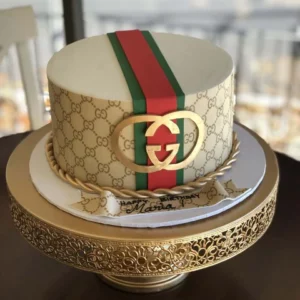
https://nestasia.in/blogs/news/top-10-cake-decorating-trends-of-the-year
Example of some of the traditional cakes.
| Pound cake & Butter cake is a classic cake, traditionally using one pound each of butter, sugar, eggs, and flour. It’s dense, delicious, and the perfect base recipe for a number of unique variations whereas Butter cake is similar to pound cake, calling for roughly equal parts eggs, sugar, flour, and of course, butter. That said it’s lighter in texture than pound cake. | 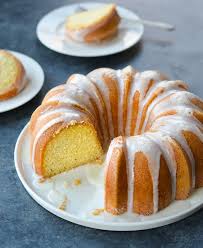 |
| Angel food cake:– Angel food cake, or angel cake, is a type of sponge cake made with egg whites, flour, and sugar. A whipping agent, such as cream of tartar, is commonly added. It differs from other cakes because it uses no butter. Its aerated texture comes from whipped egg white | 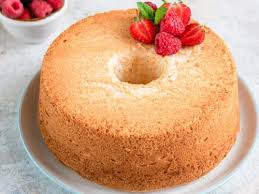 |
| Bizcocho de aceite:- is a traditional Spanish sponge cake. It’s made with a combination of eggs, milk, sugar, flour, olive oil, and baking powder. The cake batter is typically enriched with lemon zest, then poured into a shallow tray and baked until golden brown. This olive oil-flavored sponge cake is cut into smaller pieces and dusted with icing sugar before it’s served. | 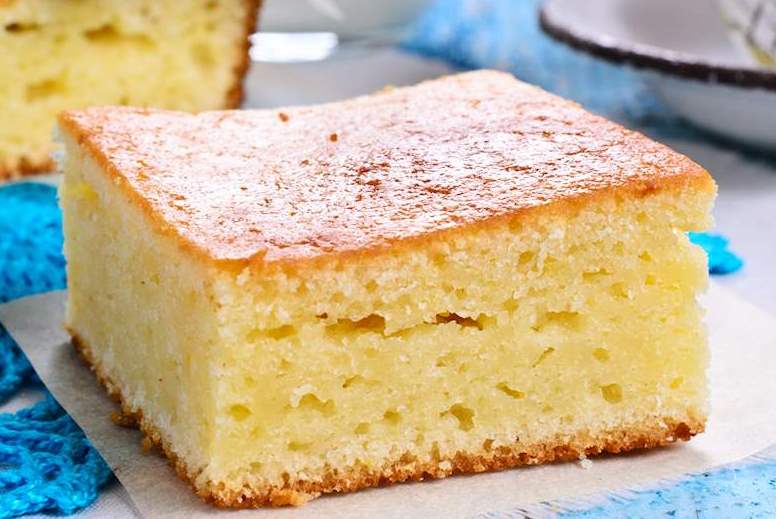 |
| Torta Garash:- This decadent cake is one of the most popular Bulgarian desserts. It consists of five delicate walnut sponges layered with dark chocolate. The whole cake is then covered in a glistening chocolate icing or creamy ganache, decorated with walnuts, desiccated coconut, sliced almonds, or chocolate ornaments. | 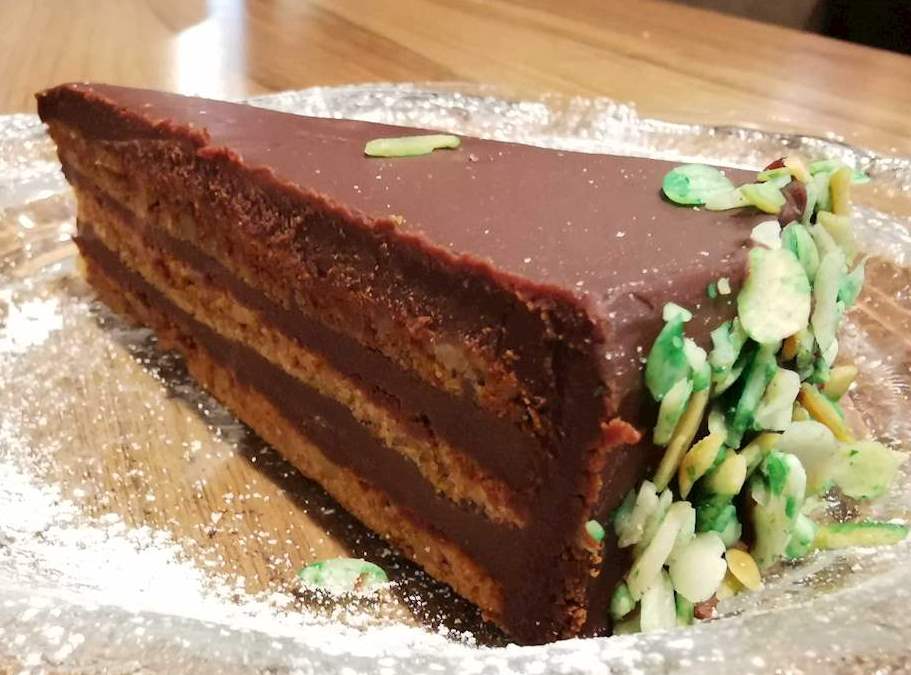 |
| Sękacz:– this famous tree cake is a vital part of traditional Polish and Lithuanian cuisine. Prepared with a thick batter which is repeatedly poured over a rotating horizontal spit, the cake is often slowly baked in the oven, or more traditionally–over an open fire. During baking, the creamy egg batter slowly drips on the sides, creating a recognizable shape of this sweet treat. | 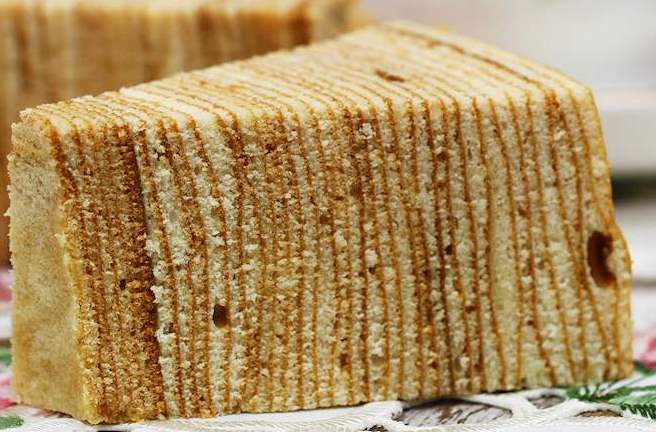 |
| Torta Paradiso:– A classic in Italian pastry is a simple sponge cake variation that mainly uses the three essential cake ingredients – sugar, flour, and butter. it a popular choice for a breakfast treat – accompanied by espresso, milk or tea. | 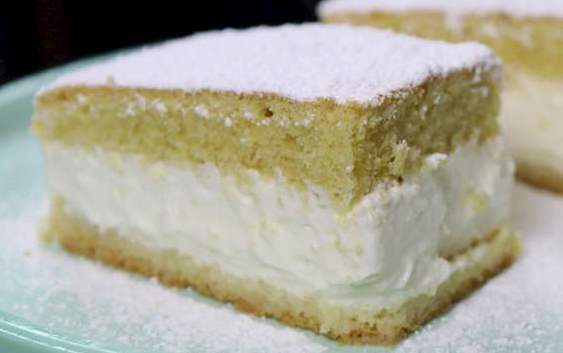 |
| Zuccotto is a famous Italian dessert believed to have originated in Florence. It is assembled by lining up softened ladyfingers or a sponge cake around the mold to create the frame of the cake, while the center is filled with a delicious, creamy filling. Finally, the cake is turned upside down before serving. It is believed that the unusual appearance of this dessert was designed to resemble the famous dome of the Florence Cathedral. | 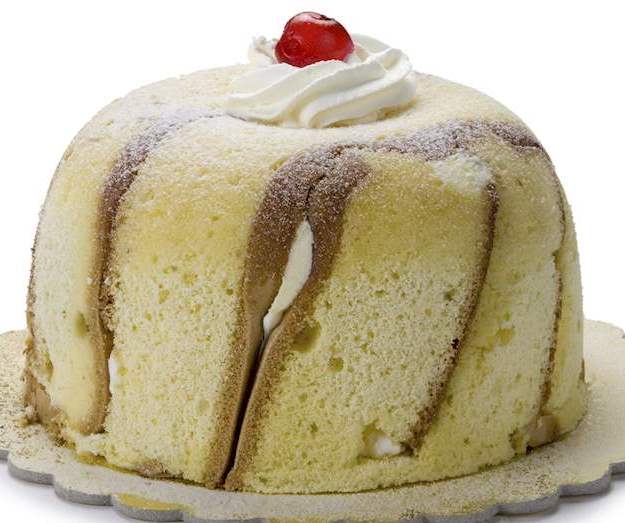 |
| Baked Alaska:-This timeless classic consists of a sponge cake base that is topped with ice cream, and the whole combination is then encased in lightly torched or browned meringue. It was an invention of pastry chef Charles Ranhofer, and it originally consisted of banana ice cream, walnut spice cake, and meringue. | 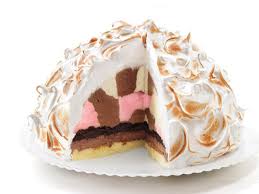 |
| Chiffon Cake:– A chiffon cake is a very light cake made with vegetable oil, eggs, sugar, flour, baking powder, and flavorings. Its distinctive feature is from the use of vegetable oil, instead of the traditional fat which is solid at room temperature, such as butter or shortening. The recipe calls for vegetable oil, which stays liquid at room temperature, to make for a moist yet light cake. Indulge in this mellow-yellow banana chiffon cake, or pucker up to this lemon chiffon cake recipe |  |
| Bundt cake:–This ring-shaped cake has an open center that allows the cake to cook evenly. However, a bundt cake does not refer to a particular recipe, but rather the characterizing feature of one is the cake shape itself, though pound cake seems to be one of the most popular recipes to use with this type of pan. | 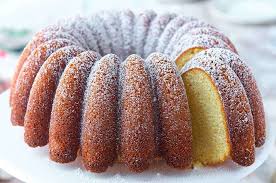 |
| Danish lagkage:-is a type of round layered cake that is usually served on special occasions. It consists of at least three layers of sponge intertwined with pastry creams, fresh fruit, or fruit preserves. The sponges can be made with various cake batters, and the whole cake is richly decorated with whipped cream and additional fresh fruits. | 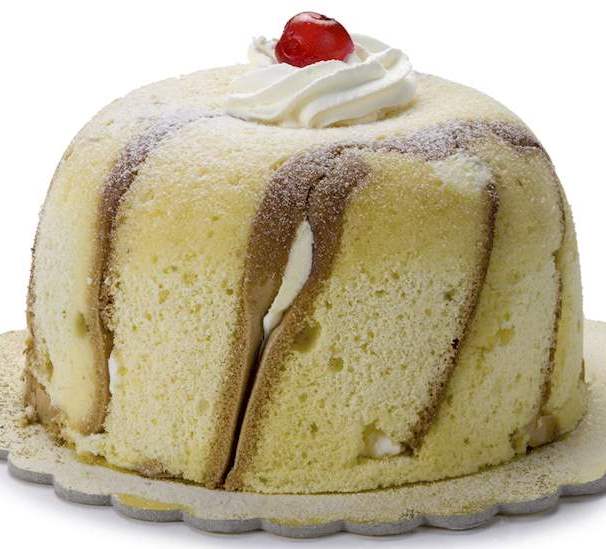 |
| Friand:-These small, delicate French cakes are similar to muffins in appearance and texture. They consist of egg whites, butter, sugar, and almond flour. These small cakes are often flavored with various ingredients such as chocolate, nuts, or pieces of fruit. They get their distinct oval shape from the special molds used to bake them. | 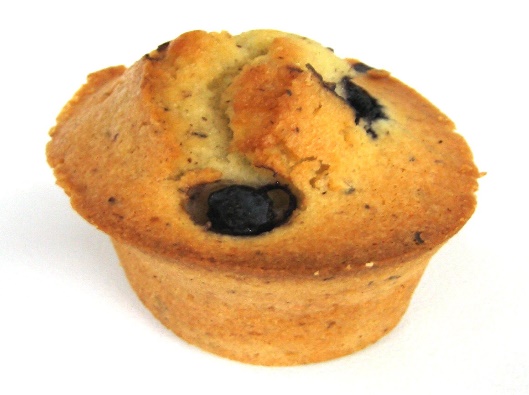 |
| Samoborska kremšnita:- is a popular dessert originating from the Croatian town of Samobor. It consists of two layers of puff pastry that are filled with custard cream. A thin layer of whipped cream is sometimes placed on top of the custard.The whole cake is typically dusted with powdered sugar, and before serving, the cake is sliced into cubes. Kremšnita can be consumed warm or chilled. | 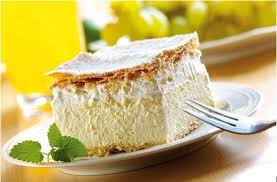 |
| Battenberg cake is a light dessert consisting of alternating, colored squares of genoise sponge coated with an exterior of apricot jam and almond paste. As per the local historian, The four sections of genoise sponge are supposed to represent the four Battenburg princes – Louis and his brothers. | 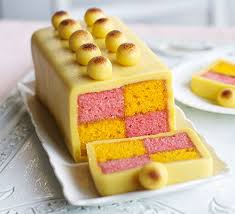 |
| Valašský frgál is a traditionally made, round-shaped sweet cake with toppings, produced in the Moravian Wallachia region in the south-eastern part of the Czech Republic. The cake has a diameter of about 30 centimetres and is golden in color when fully baked. On the surface, there is a crumble that can be additionally sprinkled with sugar, cinnamon, and gingerbread crumbs, or drizzled with butter. Nearly half of the finished product (42-48%) consists of the topping, which can be made from dried pears (the most popular variety), jam, fruits, curd cheese, poppy seeds, walnuts, cabbage, kohlrabi, or carrots. |  |
| Somloi galuska:– this classic Hungarian dessert is actually a trifle cake made of several layers of sponge and custard cream, studded with raisins soaked either in rum or the sweet Tokaji Aszú wine, then topped with whipped cream. | 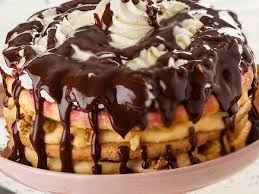 |
| Amandine is a traditional Romanian chocolate cake that’s filled either with chocolate or almond cream. The cake has four components – the sponge cake, the syrup, the filling, and the glaze. The sponge cake is made with eggs, sugar, water, flour, oil, and cocoa, the filling (chocolate buttercream) consists of eggs, sugar, butter, vanilla, and cocoa, the syrup is made with water, sugar, and rum, and the glaze is made with chocolate and whipping cream. | 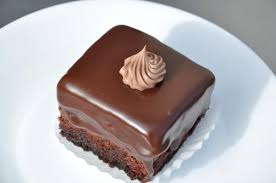 |
| Prinsesstarta:- This classic Swedish cake was originally named grön tårta (lit. green cake), due to its typical green-colored marzipan decoration. it originally consisted of sponge layers coated in vanilla-flavored buttercream which were then topped with a thick layer of whipped cream and marzipan. Modern varieties are usually dome-shaped and come with an additional layer of raspberry jelly. | 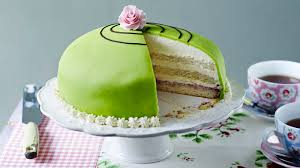 |
| Mississippi mud pie is a flavorful American dessert consisting of a cookie crust filled with numerous variable ingredients such as biscuits, ice cream, pudding, whipped cream, liqueur, and marshmallows. The pie is usually prepared in layers and often topped with almonds, pecans, chocolate syrup, or marshmallows. |  |
| Castagnaccio:- This traditional Italian chestnut cake is prepared with chestnut flour, olive oil, rosemary, raisins, and (occasionally) pine nuts. The recipe does not call for any other type of flour or sugar, making this cake a gluten-free and sugar-free delicacy. Some varieties may use other dried fruits, but the traditional version only includes raisins. | 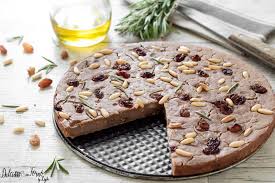 |
| Carpataka:– This popular Polish cream cake usually consists of two layers of pâte à choux coupled with a thick layer of creamy, vanilla-flavored pastry cream. Occasionally, the bottom crust is replaced with shortcrust pastry, while the top is always made with pâte à choux.When sprinkled with powdered sugar, the uneven top of the cake resembles the snow-capped Carpathian mountains, hence the name. |  |
| Bienenstich:- This classic German cake consists of a creamy filling that is enclosed between two layers of yeasted pastry dough. The cake is topped with a gooey combination of sugar or honey, cream, and slivered almonds, while the fillings typically include sweetened whipped cream or crème pâtissière. | 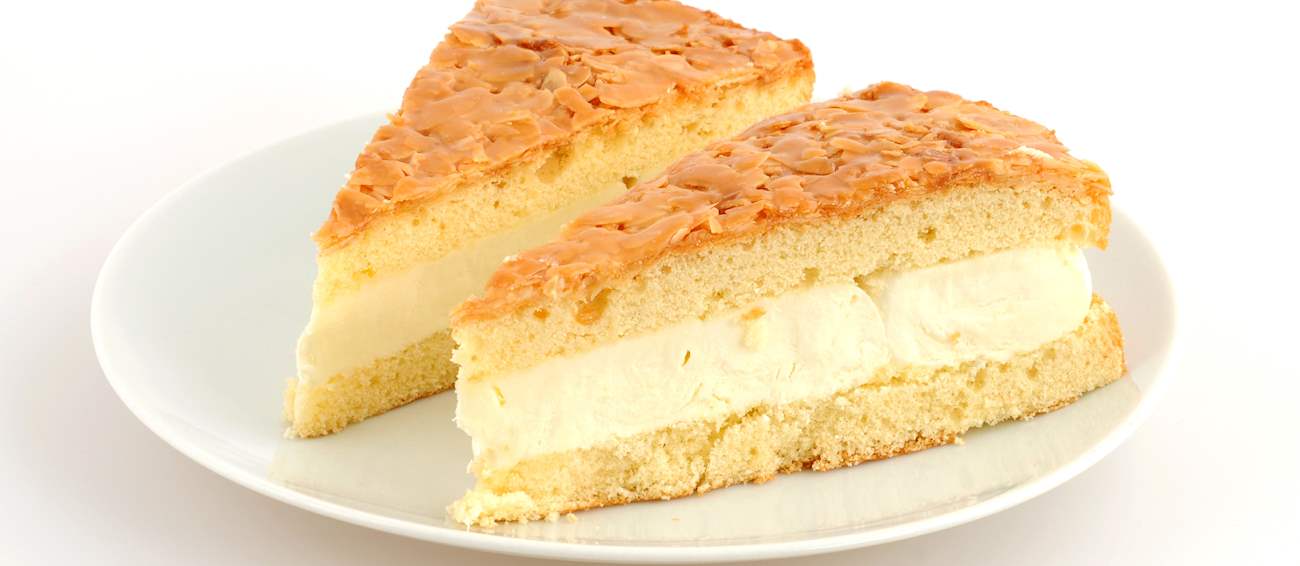 |
| Smetannik is a traditional Russian layer cake. It’s usually made with a combination of flour, sugar, eggs, honey, and a sour cream frosting consisting of sour cream, vanilla, cream cheese, and milk. The cake is traditionally made in a deep pan. |  |
| Icebox cake- Icebox cake is a sweet dessert consisting of heavy cream, sugar, and chocolate cookies or wafers. The heavy cream is typically whipped into stiff peaks and combined with cookies to form alternating layers of whipped cream and cookies. The concoction is then left in the icebox (refrigerator) to chill overnight.The cream is often flavored with vanilla. |  |
| Angel food cake:- This divine sponge cake is by far one of the sweetest and lightest American desserts. The cake is raised with egg whites and baking powder, containing no yolks or butter, which results in a buoyant sponge with a cloud-like texture. The cake is usually flavored with vanilla and accompanied by a fruit sauce, usually based on strawberries or blueberries, but it can also be topped with a light citrus-based glaze. |  |
| Japanesse cheese cake:– Known as soufflé cheesecake in Japan. this light and fluffy dessert is made by incorporating whisked egg whites into the cake mixture (eggs, milk, sugar, cream cheese), and the combination is then baked in a bain-marie. | 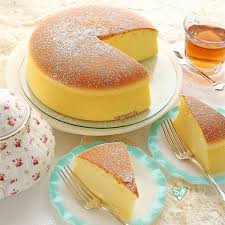 |
| Chocotorta:- Translated as chocolate cake, It is made with three Argentinian staple ingredients: chocolate biscuits, dulche de leche, and cream cheese.The cookies are softened in milk and layered with a combination of cream cheese and dulche de leche. The shapes of chocotorta can vary, while the biscuits can be soaked with chocolate milk, coffee, or even coffee liqueur. |  |
| Tompouce is a traditional Dutch pastry consisting of a thin puff pastry that is filled with cream and topped with a layer of smooth, pink icing. The dessert is usually prepared in a rectangular shape. | 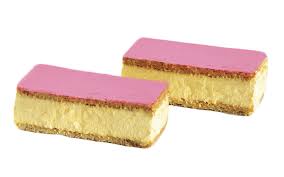 |
| Mađarica:– is a traditional Croatian layered cake that is usually associated with festive occasions. The layers are coated in a velvety, chocolate-infused cream, and the whole cake is finished with a dark chocolate glaze. | 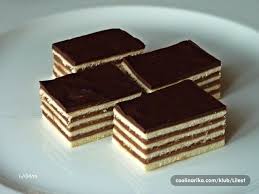 |
| Dobos torte:– It is a round cake consisting of six thin sponge cake layers and five layers of chocolate buttercream.To prevent it from drying out, the cake also has a glistening layer of hard caramel on top, while the sides are often coated with ground nuts. Before it hardens, the layer of caramel should be cut into slices with a special Dobos knife, and the pieces of caramel are then arranged on top of the cake. | 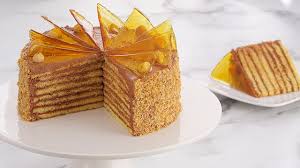 |
| Tarta de Santiago is a sponge cake made with eggs, almonds, and sugar, flavored with either lemon zest, grape marc, sweet wine, or brandy. Optionally, the cake can have a base layer made from puff pastry or shortcrust pastry. | 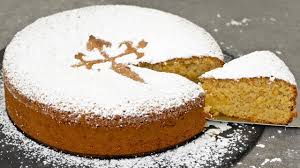 |
| Mohnkuchen :- types of open-faced and streusel cakes that couple the creamy poppy filling with a shortcrust pastry and a crumbly topping, but it can also include different types of sponge or bundt cakes. Poppy seeds are often enriched with spices, citrus zest, or liquors, and the cakes are often complemented by fruit, marzipan, or sweetened cheese. |  |
| Pampapato di ferrara:– is a traditional Italian Christmas fruitcake studded with whole almonds, hazelnuts, and candied fruit. It is flavored with cocoa, honey, cinnamon, cloves, andench buttercream. It is traditionally made with either almond or hazelnut meringue, (sometimes) black pepper. | 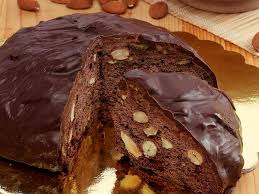 |
| Sans rival:– is a classic Filipino dessert , It is made with layers of dacquoise; a crispy, baked nut meringue sandwiched together with the so-called pâte à bombe – a gorgeously smooth, velvety and rich Fr | 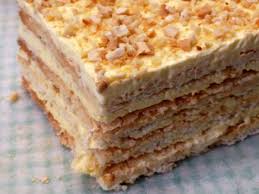 |
| Sachertorte:- The classic Sacher Torte is made with chocolate cake layers, apricot preserves and a shiny chocolate-glaze finish. Butter is melted along with the chocolate and whipped egg yolks are folded into the mixture. Flour, cocoa flour and meringue is then folded in the batter and then baked. The cake is usually finished with melted chocolate truffles. As per the traditional practice, it is customary to write the sacher on top of the cake by chocolate ganache. |  |
| Black forest Gateaux:- is a chocolate sponge cake with a rich cherry filling. This cake is very popular in swabia region of Germany which is famous for Black forest. The appearance of the cake represents the forest of this region. The cake is layered with fresh whipped cream, chopped dark chocolate or chocolate flakes and topped with maraschino cherries. |  |
| Praline gateaux:–it is a French gateaux which is made from vanilla Genoese sponge cake and layered with praline flavored butter cream & crushed praline and the cake is decorated with the roasted almond flakes and sprinkle with crushed praline. | 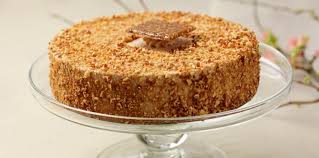 |
| Mud Cake:- it is very popular in Mississippi America. It is basically a pie which is prepared with dark chocolate sponge and very similar to the brownie. Cake is usually layered with the dark chocolate fudge and garnish with cocoa powder | 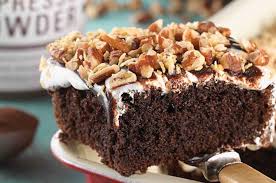 |
| Yule log cake:– yule log cake is chocolate cake filled with whipped cream, rolled into the shape of a log, and coated with a chocolate ganache. Traditionally this cake is filled with flavoured butter cream and then it is rolled and wrapped in paper and refrigerated until chilled. It is coated with butter cream and groves are made so that it looks like a bark or log of wood. Yule log cake is also known as Buche de Noel. | 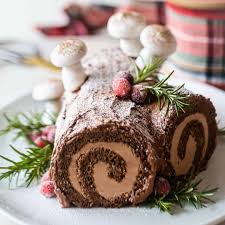 |
Content reference:-
The prime moto while preparing the above content is to educate the students who are pursuing carrier in Hospitality & food trade, Hoteliers, chefs, Hotel Management faculty members, Housewife’s etc. The above content has been compiled after referring various culinary books, Research Papers, Research articles, Food magazines, news papers, top culinary websites, Govt websites, personal interaction with renowned chefs from various hotel brands like The Ashok Group of hotel, ITC, Oberai, Leela, Park Hotels & various IHM Faculties, Nutritionists etc. & many more. The picture which i have used has been taken from the open source website .Some of the important website referred for the above content are:-
- https://www.epicurious.com/expert-advice/types-of-cake-glossary-article
- https://www.kitchenaid.com/pinch-of-help/stand-mixers/types-of-cakes.html
- https://www.tastingtable.com/944685/types-of-cake-explained/
- https://www.fifteen.net/types-of-cakes/
- https://www.merriam-webster.com/dictionary/cake
- https://penyrheol-comp.net/technology/wp-content/uploads/sites/2/2014/06/Cake-Making-Methods.pdf
- https://www.stcuthberts.com/media/4765/cake-making-intro.pdf
- https://ncse.ie/wp-content/uploads/2020/05/Cake.pdf
- https://www.kingarthurbaking.com/blog/2017/04/28/cake-mixing-methods
- https://www.bestrecipes.com.au/baking/galleries/classic-cake-recipes/ttibrs5u
- https://www.bbcgoodfood.com/recipes/collection/classic-cake-recipes
- https://bakeryinfo.co.uk/finished-goods-reports/what-do-classic-cakes-look-like-across-the-globe/654494.article
- https://nestasia.in/blogs/news/top-10-cake-decorating-trends-of-the-year
